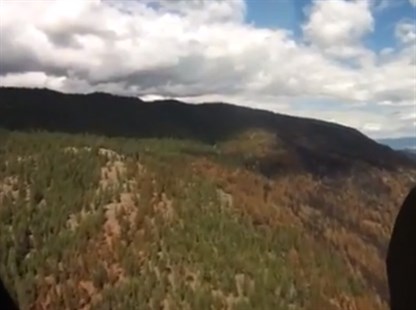
From above, you can see more green and brown than black, meaning there's still plenty of fuel for a future fire.
(MARSHALL JONES / iNFOnews.ca)
July 31, 2014 - 4:10 PM
WEST KELOWNA - Smith Creek and Tallus Ridge were initiated into the fraternity of Central Okanagan neighbourhoods evacuated and threatened by fire but with one significant difference — they remain at risk of an interface fire and are perhaps at an even greater risk because of it.
Glenrosa, Goat’s Peak, Rose Valley and Westside Road communities behind the Terrace Mountain fire in 2009, as well as most of the southern border of Kelowna in 2003 had the same snap evacuations, fear and worry their homes would be burned. But in those cases, the fires were stoked by overloaded fuels and heavy winds to burn nearly everything in its path, including 239 homes in Kelowna. Charred trees or cleared areas are all that remain and created a natural fire break for all those neighbourhoods, a natural point for firefighters to make their stand against an oncoming forest fire that may start at any point in the bush beyond.
Not Smith Creek. West Kelowna Fire Chief Wayne Schnitzler says there’s still plenty of fuel in the hills.
"The thing about this fire compared to Glenrosa is it consumed all the trees,” he says. “This one is still a little spotty. In some areas it consumed lots of forest and (moved through the canopies) but there were other areas where it was a ground fire and there’s still lots of green space left.”
While Tallus Ridge has plenty of cleared land separating homes from the dense bush, Smith Creek remains right on the forest’s edge. Looking at charred remains from above, the fire moved in typical random fashion, burning hot and consuming everything in one area, but still leaving great swaths of green and now brown and dead trees further dried out and at even greater risk for future fires.
Incident Commander Mike Monzon said Friday they will stay till the last hot spot is out.
“There’s enough fuel still around for a fire, from a lightning strike or some careless individual,” he said.
It’s well established that interface areas—where the forest meets the neighbourhood—need fuel reduction, preferably not by wildfire unless it gets the job done without sacrificing structures.
The District of West Kelowna and Central Okanagan Regional District have used their share of the province’s Wildfire Protection Program to reduce and remove fuels in parks and other areas, but Schnitzler says it's not enough. While he praises private landowners from Tallus Ridge and Smith Creek, private lands are the linchpin in the system.
“We cannot apply for funding to take care of private lands,” he says. “When it comes down to it, it’s a forest that’s owned privately and that is their responsibility. But a lot of the work is hugely expensive and it's something the province hasn’t moved forward with for funding. The municipal areas are surrounded by private landowners. We can make recommendations on how to make property safer but we can’t make them take down trees on their property.”
It's something the province needs to consider, he says. The provincial government paid for municipalities to mitigate fire risk through the Wildfire Protection Program, which shelled out $61 million since 2001 and the province is considering renewing it. For now, Schnitzler just hopes this fire was another reminder for homeowners to take care of fuel on their own properties. If you need advice on how to do that, contact your local fire department for details.
In the hills above Smith Creek right now, helicopters are almost a rare site, fire crews are dwindling, the smoke is mostly gone and the emergency operations centre disbanded on Wednesday, mostly owed to last week’s rains and the tireless work of ground crews putting out the fires.
Fire Information Officer Kelsey Winter says while the fire danger rating isn't extreme, the rating will likely get there soon with the forecast calling for temperatures in the low to mid-30s with little rain for relief in sight.
“It doesn’t take long to dry right out again,” she says.
— Marshall Jones is the editor of infonews.ca. Reach him at mjones@infonews.ca or call 250-718-2724.
News from © iNFOnews, 2014